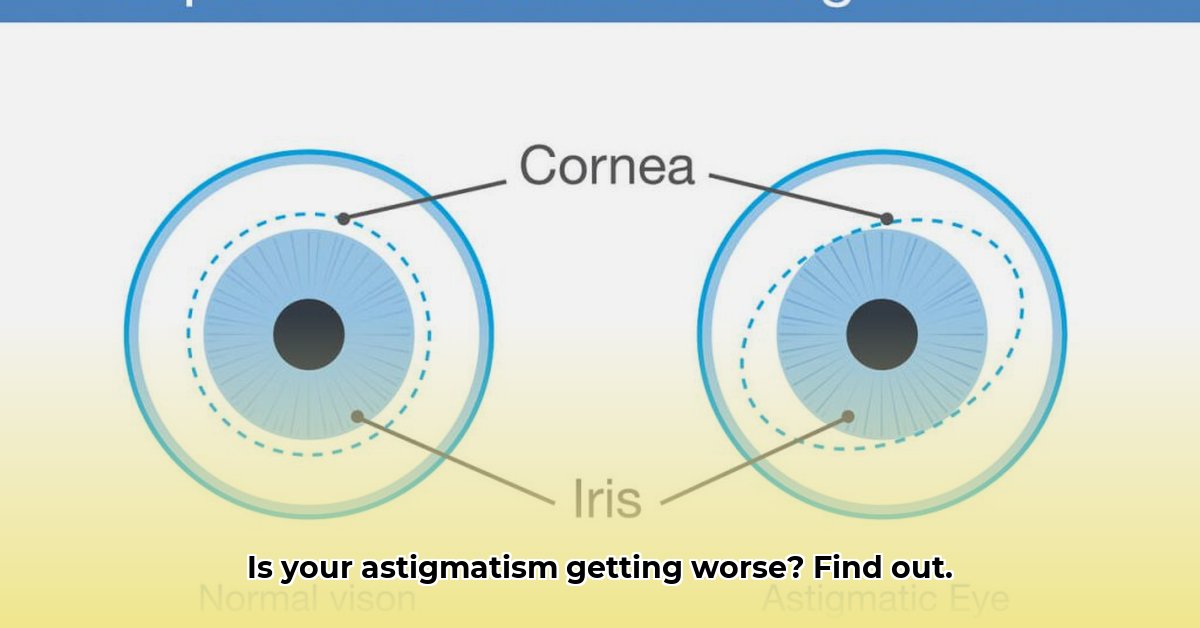Worried about your astigmatism? You’re not alone. This article explains whether astigmatism changes over time and what you can do. We’ll cover why it might worsen, how to manage it with glasses and contacts, and provide a plan to keep your vision sharp. Learn how to potentially slow down changes and ensure your vision stays great through the years. Understanding the contributors is key to caring for your eyes.
Understanding Astigmatism: Does it Progress?
Astigmatism is a common vision problem where your eye doesn’t focus light correctly, resulting in blurry vision. This is usually due to an irregularly shaped cornea (the clear front part of your eye) or lens. But does this blurry vision worsen over time? The answer is maybe. It’s not a simple “yes” or “no” because several factors can influence astigmatism progression.
Factors Influencing Astigmatism Changes: Aging and Eye Conditions
Several factors can influence whether your astigmatism changes. Aging is a significant factor; as we age, our eyes naturally change shape, which can affect how light focuses. Eye injuries also play a role – even minor bumps or scratches could affect the cornea’s shape. Genetics also play a part; if your family has astigmatism, you’re more likely to have it, and it may be more likely to change. Furthermore, lifestyle factors, such as prolonged screen time and poor lighting conditions, can also contribute to the worsening of astigmatism.
Underlying eye conditions can also worsen astigmatism. Keratoconus, where the cornea thins and bulges, significantly impacts how light focuses, leading to blurry vision and worsening astigmatism. Regular checkups are vital for early detection.
Recognizing Vision Changes: Early Detection
How do you know if your astigmatism is worsening? Pay attention to your vision. Are things fuzzier than usual, especially at night? Do you squint more often? Are headaches or eye strain more frequent? These signs indicate something might be changing, warranting a checkup. Early detection makes a big difference, so don’t wait until your vision is unbearable. Also, take note if you’re experiencing increased sensitivity to light or glare, or if you notice halos around lights. Any of these symptoms could indicate a change in your astigmatism.
Effective Astigmatism Management: Monitoring and Correction
Regular eye exams are crucial, regardless of your vision problem. Your eye doctor can monitor your eye health and spot any changes in your astigmatism early. The frequency of exams depends on your individual situation and astigmatism severity, but annual check-ups are generally recommended for adults and children over 6. Glasses and contact lenses are common ways to correct it and may suffice for many. However, surgery might be an option for some. LASIK and PRK are refractive surgeries that can reshape the cornea to improve your vision. Your eye doctor can help you understand if surgery is right for you, considering your overall eye health and astigmatism severity before recommending any treatment.
Proactive Steps: For You and Your Eye Doctor
Here’s a breakdown of what you can do to manage your astigmatism:
For You:
- Regular Checkups: Schedule eye exams as advised by your doctor. This is your best defense.
- Report Changes Immediately: Don’t wait to tell your doctor if you notice any vision changes, no matter how small.
- Protect Your Eyes: Wear protective eyewear during activities that could cause eye injuries to prevent unexpected changes to your vision.
- Minimize Eye Strain: Make it a habit to avoid using screens for long periods and ensure you have proper lighting when reading or working.
- Healthy Lifestyle: Maintain a balanced diet rich in vitamins and minerals that support eye health.
For Eye Doctors:
- Thorough Exams: Eye doctors should perform comprehensive eye exams, including checks for conditions like keratoconus.
- Personalized Plans: Treatment plans should be tailored to each patient’s needs and risk factors.
- Staying Current: Doctors need to keep up with the latest advancements in astigmatism treatment.
- Corneal Topography: Eye doctors also use corneal topography to get a closer look at your cornea, including how it curves.
Impact of Early Intervention: A Sharp Vision Ahead
Early detection and proper management can significantly improve your quality of life. Don’t hesitate to seek professional help if you notice subtle changes in your vision. A customized plan can help prevent vision problems and keep your vision sharp. Regular checkups are key to managing astigmatism, helping you enjoy life to the fullest! Astigmatism can worsen, but with consistent care and monitoring, you can help keep it under control. Ongoing research continues to improve our understanding of astigmatism, so things may change in the future.
How to Slow Astigmatism Progression with Contact Lenses
Astigmatism can sometimes worsen over time. Contact lenses are a potent correction method, but improper use can negatively impact your eyes. Maintaining meticulous lens hygiene is crucial for preventing complications. Regular comprehensive eye exams are essential for monitoring astigmatism and its progression. Choosing the right type of contact lens and adhering to the recommended wear schedule is paramount. Age-related changes in the eye structure often contribute to the progression; lifestyle choices can play a role. Several effective treatments exist, from corrective lenses to surgical interventions.
Astigmatism and Progression: A General Overview
Astigmatism occurs when the cornea (the eye’s clear front surface) isn’t perfectly round, causing blurred vision at all distances. Does astigmatism inevitably worsen? Not necessarily. While it often stabilizes in adulthood, several factors can influence its progression. Genetics plays a significant role, but environmental factors and lifestyle choices can also impact your eye health.
Contact Lenses: Management Strategies for Astigmatism
Contact lenses are a popular vision correction method. Toric contact lenses—designed specifically for astigmatism—work by precisely correcting the irregular curvature of your cornea. How to slow astigmatism progression with contact lenses isn’t just about having the correct prescription; it’s about responsible use. Additionally, Orthokeratology, or “ortho-k,” involves wearing specially designed rigid gas-permeable contact lenses overnight to temporarily reshape the cornea.
Essential Lens Hygiene: Best Practices
Improper lens care can irritate your eyes, possibly increasing inflammation and discomfort, potentially exacerbating your astigmatism symptoms. How can you minimize this risk?
- Thorough Cleaning: Always follow your eye doctor’s instructions for cleaning and storing your lenses. Clean them meticulously after each removal, using the recommended solution.
- Regular Replacement: Replace your lenses according to the prescribed schedule. Old or damaged lenses can harbor bacteria and cause infections. Daily disposables are the safest option.
- Proper Storage: Never reuse contact lens solution. Store your lenses in a clean case with fresh solution each night. According to the American Academy of Ophthalmology, this is crucial.
- Avoid Tap Water: Always use sterile contact lens solution for rinsing and storing your lenses. Tap water can contain microorganisms that can lead to serious eye infections.
- Wash Hands: Always wash and dry your hands thoroughly before handling your contact lenses to prevent the transfer of dirt and bacteria to your eyes.
Vision Monitoring: Regular Eye Examinations
Regular eye exams (at least yearly, possibly more often depending on your needs and age) are crucial for monitoring your astigmatism. Your eye doctor can detect early changes and adjust your prescription as needed. Early intervention can help significantly in managing progression. These exams can also identify other potential eye issues that could be contributing to changes in your vision.
Selection Criteria: Contact Lenses for Astigmatism
The type of contact lens you use matters. Daily disposable lenses, for example, minimize the risk of infection and greatly reduce the buildup of debris that could potentially impact your astigmatism. Discuss different lens options with your eye doctor to determine the most suitable choice for your needs. They’ll consider your individual eye health and lifestyle factors when recommending the best option. Rigid gas-permeable (RGP) lenses are also an excellent choice for astigmatism, as they provide a stable and clear vision by maintaining their shape on the eye.
The Long-Term Vision: Age and Astigmatism
Astigmatism can worsen with age due to changes in the cornea and lens. These structural alterations often happen gradually, but can become more noticeable after eye injuries or surgeries. Maintaining a healthy lifestyle, including UV protection and regular eye exams, becomes especially important as you age. Ageing: Your vision may be impacted as you age due to changes in the curvature of your cornea and lens.
Treatment Options: Beyond Contact Lenses
While contact lenses are a key tool, they aren’t the only approach. Other options include glasses, orthokeratology (reshaping the cornea overnight with special lenses), and refractive surgery (like LASIK). Your doctor will help in determining the best treatment plan based on your specific situation. Laser vision correction, such as LASIK or PRK, can permanently reshape the cornea to correct astigmatism. Refractive lens exchange involves replacing the eye’s natural lens with an artificial lens that corrects astigmatism.
Comparing Astigmatism Management Options for Different Age Groups
Astigmatism often changes with age. These changes can impact vision and necessitate adjustments in corrective measures. Comparing Astigmatism Management Options for Different Age Groups reveals customized approaches are crucial. Several effective treatments exist, ranging from glasses and contact lenses to surgical interventions. Regular eye exams are essential for monitoring astigmatism and its progression.
Age-Related Vision: Astigmatism Impact
Have
- Gluten Free Meal Prep Ideas for Delicious, Hassle-Free Eating - November 28, 2025
- Gluten Free Meal Prep for Stress-Free and Healthy Eating - November 27, 2025
- Quick And Easy Chicken Thigh Meal Prep For Weight Loss - November 26, 2025










